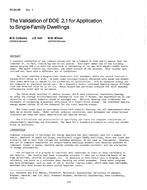Description
A computer simulation of any complex system must be validated in some way to ensure that the computer is, in fact, simulating the actual system. This paper makes use of the building energy program DOE 2.1A with the objective of validating it for use with single-family dwellings. The major concern is, therefore, the loads portion of the program. Four studies were carried out, each with a different set of conditions.
The first involved a single-story house with full basement, while the second involved a single-story house on a slab. In both cases occupant-related variables were known and blower-door tests were run to assist in the estimation of infiltration. Utility-measured energy use was compared to simulated energy use. On a bimonthly basis, simulated heating energy differed from the measured value by up to 11 percent. These houses had gas-fired furnaces for which seasonal efficiencies could only be estimated.
The third study involved 75 similar houses, which used electrical resistance heating. By using the average utility-measured consumption from the 75 houses, any abnormalities in construction or occupant behavior would be averaged out. Electric heating also eliminated the necessity of estimating a seasonal efficiency of a fossil-fired system. The simulated heating energy agreed within 5 percent of the measured for the total heating season.
The final study used an unoccupied house with electric heating, and all measurements were made on an hourly basis. Under certain selected conditions, good agreement was shown between simulated and measured space temperatures and heating energy.
The difficulties and uncertainties of specifying the input for computer simulations of single-family dwellings are discussed. The need for a standard procedure to carry out validations is indicated.
Citation: Symposium, ASHRAE Transactions, 1984, vol. 90, pt. 2B, Kansas City, MO
Product Details
- Published:
- 1984
- Number of Pages:
- 13
- File Size:
- 1 file , 1.1 MB
- Product Code(s):
- D-KC-84-05-1




